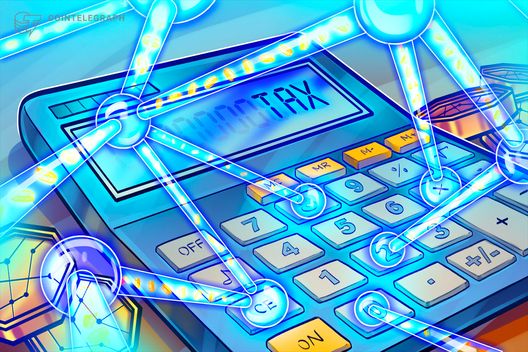
Sergej Kunz, Mitbegründer von 1inch, erklärte, dass es in zwei bis drei Jahren einen Multichain-DeFi-Stack geben könnte, der einen freien Liquiditätsfluss zwischen Netzwerken ermöglicht.

Finanzmittel Info + Krypto + Geld + Gold
Krypto minen, NFT minten, Gold schürfen und Geld drucken

Sergej Kunz, Mitbegründer von 1inch, erklärte, dass es in zwei bis drei Jahren einen Multichain-DeFi-Stack geben könnte, der einen freien Liquiditätsfluss zwischen Netzwerken ermöglicht.

Ein DeFi-Investor sollte 9 Mio. Euro Steuern nachzahlen, weil die spanische Steuerbehörde einen Krypto-Kredit als steuerpflichtigen Gewinn eingestuft hat.
While cryptocurrencies retreated from their recent peaks, Anthony Scaramucci’s alternative investment company, SkyBridge Capital, supercharged Avalanche’s (AVAX) fundamentals.
According to the latest press release, SkyBridge plans to tokenize hedge funds worth $300 million on the Avalanche network.
Under this initiative, SkyBridge’s Legion Strategies Ltd. and Digital Macro Masfer Fund Ltd. will tokenize on AVAX’s network through leading financial service providers Apex Group and Tokeny.
Commenting on the move, SkyBridge’s CEO and founder, Anthony Scaramucci, stated:
Tokenizing our funds on Avalanche, supported by the technology and operational infrastructure of Tokeny and Apex Group, represents a significant step forward in modernizing the alternative investment landscape.
We look forward to bringing our hedge funds into the digital, on-chain era, improving transparency, liquidity, and accessibility for our investors.
The news renewed sentiments around AVAX’s potential amidst the ongoing broad market bloodbath.
Digital assets trade in the red as Bitcoin falls below $114,000.
Nevertheless, analysts remain bullish, perceiving the current correction as a healthy one after BTC’s surge to all-time highs of around $124,000.
With large-cap altcoins in the traders’ radar after the recent Ethereum rally, this article checks AVAX’s potential comeback once market sentiments improve.
The real-world assets (RWAs) sector is experiencing significant growth momentum as DeFi and TradFi converge.
Hedge fund tokenization will enrich Avalance’s ecosystem, as it already hosts tokenized credit, stocks, private equity, venture, and MMFs.
Avalanche already hosts tokenized MMFs, private equity, credit, stocks, venture & now hedge funds.
Tokenization on Avalanche is bridging TradFi and DeFi with new distribution channels and programmable products.
🔺 This is where capital connects.
https://t.co/vEZbo1c4ft— Avalanche🔺 (@avax) August 19, 2025
SkyBridge decision sets AVAX for impressive performance in the coming sessions.
The price chart supports a bullish case, pointing to a potential AVAX recovery to $32.
That would mean an over 45% gain from the altcoin’s current price.
Financial institutions are never random when venturing into crypto.
Avalanche’s EVM compatibility, near-instant finality, and scalability likely attracted SkyBridge.
The $300 million initiative unlocks the AVAX platform for large-scale tokenization.
According to Tokeny co-founder Danie Coheur:
SkyBridge’s tokenization on Avalanche proves that with the right technology, trusted operators, and regulatory clarity, tokenization at scale is not just possible, it’s happening.
While the tokenization updates strengthen Avalanche’s fundamentals, broad market weakness weighs on AVAX’s performance.
The alt hovers at $22 after losing around 1.80% in the past 24 hours.

AVAX remained relatively calm as markets crashed ahead of Powell’s anticipated speech.
Meanwhile, Avalanche looks poised to lead the next leg up, fueled by institutional interest, especially if SkyBridge succeeds in its plans.
Such a narrative aligns with the bullish chart pattern.
The Elliot Wave analysis shows that AVAX is finalizing a wave two correction.
This setup phase often precedes a massive wave three rally.
The structure highlights possibilities of recoveries to the $32 ceiling.
That would be an approximately 45% surge from AVAX’s market price.
However, improved broader market sentiments remain vital to support the upside.
Failure to overcome the obstacle between $26 and $27 will likely delay the projected AVAX recovery.
The post AVAX price outlook: SkyBridge Capital to tokenize $300M on Avalanche blockchain appeared first on CoinJournal.
SoFi Bank is preparing to shake up the global remittance industry by introducing a blockchain-powered international money transfer service.
The US digital bank has partnered with Lightspark, a Bitcoin infrastructure company founded by former PayPal president David Marcus, to bring faster and cheaper cross-border payments directly into its app.
The new service will allow SoFi customers to send money abroad without relying on traditional remittance providers or third-party platforms.
Instead, transfers will be powered by the Bitcoin Lightning Network and Lightspark’s Universal Money Address, or UMA.
SoFi + Lightspark = instant global payments. 🌍⚡
Send money abroad in seconds, right from the @sofi app, powered by UMA.
Coming soon for 🇺🇸→ 🇲🇽 with more countries to follow.
The future of global payments is here: https://t.co/MxAA5o9k2Z pic.twitter.com/GFVq4KhoxF
— Lightspark (@lightspark) August 19, 2025
This technology is designed to move dollars across borders instantly, at any time of the day, while ensuring that fees and exchange rates are displayed clearly before each transaction.
SoFi says the service will debut later this year, beginning with Mexico, a key remittance corridor from the United States.
Once rolled out, users will be able to initiate transfers directly through the SoFi app, where US dollars will be converted into Bitcoin, routed across the Lightning Network, and then converted back into the recipient’s local currency before being deposited in their bank account.
Notably, this is not SoFi’s first step into the digital asset space.
The bank began offering crypto trading in 2019, but later scaled back the service following regulatory concerns during the collapse of FTX.
However, with a federal banking license secured and new rules under the GENIUS Act offering greater clarity, SoFi is reentering the sector more aggressively.
During its most recent earnings call, the company outlined ambitions beyond remittances.
These include plans for stablecoin issuance, crypto-backed loans, and staking infrastructure for other institutions.
By positioning itself as a bridge between traditional banking and Web3, SoFi hopes to secure a long-term advantage over pure-play crypto platforms.
The promise of speed and lower costs is central to SoFi’s plan.
Traditional remittances often take days to clear and can cost families as much as 6% of the amount being sent.
By embedding blockchain rails into its platform, SoFi expects to deliver a service that is available around the clock and significantly below the national average cost of remittances in the United States.
Anthony Noto, SoFi’s chief executive, emphasised that many of the bank’s members rely on sending money to loved ones overseas.
He said that building blockchain transfers directly into the SoFi app will give users “faster, smarter, and more inclusive access” to their funds.
The bank is also opening a waitlist to meet early demand and gauge interest from members who frequently send money abroad.
Lightspark, which launched in 2022, has been positioning its UMA as a universal standard for moving money globally in a way that feels as simple as sending an email.
According to Marcus, Bitcoin is the only open payments network that can power such transactions securely and at scale.
Marcus added that UMA on SoFi will allow members to move dollars instantly with full transparency and control, while avoiding the delays of traditional systems.
The collaboration makes SoFi the first US bank to integrate Bitcoin’s Lightning Network and UMA at this scale.
It also comes at a time when other major institutions, including Bank of America and JPMorgan, are testing blockchain for their own transfer systems.
The post SoFi Bank to start using Bitcoin for cross-border payments appeared first on CoinJournal.
US spot Bitcoin and Ether exchange-traded funds (ETFs) saw significant net outflows on Tuesday, with institutional investors trimming exposure ahead of key macroeconomic events later this week.
Data from SoSoValue showed spot bitcoin ETFs recorded daily net outflows of $523 million on Tuesday, excluding numbers from Invesco’s BTCO, which were not published.
Fidelity’s FBTC accounted for the largest share, with $246.9 million in negative flows.
Grayscale’s GBTC saw $115.53 million in outflows, while products from Bitwise and Ark & 21Shares also recorded sizable redemptions.
BlackRock’s IBIT reported no flows for the day.
Spot Ether ETFs experienced $422.3 million in total net outflows, according to SoSoValue.
Fidelity’s FETH led with $156.32 million in withdrawals, followed by Grayscale’s ETHE at $122 million.
The Grayscale Mini Ethereum Trust also saw $88.5 million in outflows.
Tuesday’s figure marked the second-largest daily net outflows from spot ether ETFs since their debut.
Market participants had earlier expected the US Federal Reserve to lower interest rates in September.
However, last week’s producer price index, which came in hotter than anticipated, reduced confidence in that outlook.
Investors are now waiting for additional cues, including the release of minutes from the Federal Open Market Committee’s July meeting later on Wednesday, and a speech by Fed Chair Jerome Powell at the Jackson Hole symposium on Friday.
Bitcoin, Ethereum, and Ripple extended their declines this week, each closing below important technical support levels.
Bitcoin fell beneath its ascending trendline and the 50-day exponential moving average (EMA), closing at $116,300 earlier in the week before slipping further on Tuesday.
It was trading at around $113,400 on Wednesday, showing a slight recovery.
Analysts are watching $111,980 as the next major support level if selling pressure continues.
Ethereum, which hit a yearly high of $4,788 last Thursday, retreated nearly 14% in the following five days.
It was trading at approximately $4,132 on Wednesday. If the resistance at $4,232 holds, further downside could push the price toward $3,946.
XRP also weakened, closing below its 50-day EMA at $2.93.
The move suggested further downside risks alongside bitcoin and ether, adding to the cautious outlook for digital assets this week.
The post Bitcoin, Ether ETFs record heavy outflows as traders await Fed signals appeared first on CoinJournal.